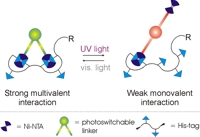
Institute of Biochemistry, Biocenter, Marie-Curie-St. 9, D-60439 Frankfurt/Main, Germany

 |
Alart Mulder, Jörg Wissler, and Robert Tampé
Institute of Biochemistry, Biocenter, Marie-Curie-St. 9, D-60439 Frankfurt/Main, Germany |
 |
The labeling and immobilization of biomolecules by means of multivalent interactions are currently of high scientific interest. One of the foremost used interaction modes in this respect is that between the Nickel complex of N-Nitrilotriaceticacid (Ni-NTA) and oligohistidine tags (His-tags). These multivalent interactions are highly specific and fully reversible when exposed to high concentrations of immidazol. Unfortunately, the use of competitors in solution typically leads to a general dissociation.
Here we present a new class of biochemical tweezers based on multivalent Ni-NTA moieties, the binding affinity of which can be controlled by an external stimulus: light. We have synthesized a series of photoswitches in which the metal-chelating moieties are coupled via a photochromic linker. The conformation of the photochrome can be controlled by irradiation with light and determines the extent of cooperation between the two Ni-NTA moieties in binding His-tags, and thus the affinity of the interaction. The synthesis of these biochemical tweezers will be discussed together with binding studies with His-tagged proteins. We envision that many applications of labeling and immobilization techniques would benefit tremendously from a possible local dissociation (or activation); consider for example site-specific labeling in cells, local surface activation for the creation of protein arrays, etc.